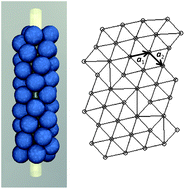Self-assembly on a cylinder: a model system for understanding the constraint of commensurability†
Abstract
A crystal lattice, when confined to the surface of a cylinder, must have a periodic structure that is commensurate with the cylinder circumference. This constraint can frustrate the system, leading to oblique crystal lattices or to structures with a chiral seam known as a ‘line slip’ phase, neither of which is stable for isotropic particles in equilibrium on flat surfaces. In this study, we use molecular dynamics simulations to find the steady-state structure of spherical particles with short-range repulsion and long-range attraction far below the melting temperature. We vary the range of attraction using the Lennard-Jones and Morse potentials and find that a shorter-range attraction favors the line-slip. We develop a simple model based only on geometry and bond energy to predict when the crystal or line-slip phases should appear, and find reasonable agreement with the simulations. The simplicity of this model allows us to understand the influence of the commensurability constraint, an understanding that might be extended into the more general problem of self-assembling particles in strongly confined spaces.


 Please wait while we load your content...
Please wait while we load your content...